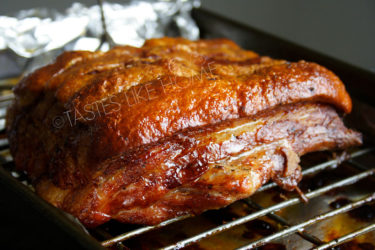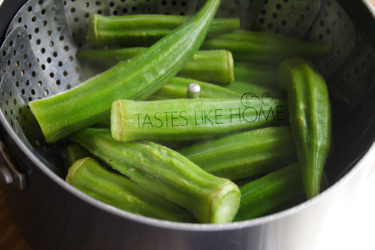Hi Everyone,
What’s Cooking is a series in which I answer questions you may have about food and cooking but are too shy to ask.

Remove the pan from the oven while the custard still has a little jiggle in the middle.
Take the pan with the roast out of the oven, cover it loosely with foil and let rest for 20 – 30 minutes before carving.
All of the above sounds familiar right? They are directions/instructions given in various recipes and, in each case, it has to do with carryover cooking – letting the cooking process continue away from direct contact with heat or to immediately stop the cooking process. Let’s look at both scenarios.
Carryover Cooking – finish cooking off direct heat

Photo by Cynthia Nelson
Carryover cooking occurs when some foods retain heat and continue to cook even though they have been removed from the source of heat. In other words, even though the food has been removed from the stovetop, oven, or grill, it maintains its heat that will finish the cooking process. Carryover cooking is sometimes referred to as resting. One of the best and easiest examples to give is the cooking of steaks and burgers.
A restaurant that serves steaks and an eatery that prides itself on its burgers should always ask you, “How would you like your steak?” or “How would you like your burger?” Your response would tell the chef how long (duration) and at what temperature to cook your steak or burger. And more importantly, it will let the chef know at what stage your steak or burger should be removed from direct heat so that it can finish cooking while it rests, before being plated and brought to your table.
Without getting scientific, and again, using meat as the best example, here is what occurs with carryover cooking. The exterior of meat (such as a roast) gets hotter much quicker than its interior, and heat always moves from a hot to a cool area. Because of this difference in temperature in the exterior and interior, when a roast/meat is removed from a direct heating source, the heat from the hotter outer surface will travel inwards to the cooler interior. This transfer will raise the temperature of the interior of the meat. This movement of heat will slow down and eventually stop; the internal and external temperatures will meet and even out each other. Only then is it ready to be cut, sliced, or carved.
In addition to meats (roasts and thick cut steaks and chops – lamb, pork, beef etc.), fish, eggs, and liver also benefit from carryover over cooking. What this means is that when cooking these ingredients, you will always be instructed by a recipe to remove the food from the oven, stove, grill, or pan, at a certain period of time before it is done fully cooking. The cooking time given in a recipe would have factored in carryover cooking (resting) when removed from the heat. For example, a recipe outlining the following details would have taken into consideration the phenomenon of carryover cooking: the cut of steak, thickness, the level of heat, degree of doneness, and the period of direct-heat cooking time, as well as removal of the steak from the pan, resting place, and resting time.
Furthermore, recipes of dishes that involve carryover cooking will be keen to inform you whether the food should rest off the heat in the pan/pot in which it was cooked, or if it should be removed from its cooking vessel and be left to rest on a surface such as a cutting board, platter or cooling rack. Always be guided on carryover cooking by your recipe, but remember, cook with confidence, and make the food the way you like it.
The Other Side of Carryover Cooking – stop the cooking altogether

On this side of cooking, carryover cooking is when the cooked food is left in the hot pot or pan in which it was cooked, or when that hot pot/pan has been left sitting on a hot cooking surface that takes a while to cool down even though the heat has been turned off. Electrical cooktops such as Ceramic and metal spiral burners retain heat for as much as 15 – 30 minutes after cooking depending on the size of the burner, the pot/pan and the actual food that was cooked in them. For example, Pelau, Cook-up Rice, and heavy soups maintain heat for sometime after they are done cooking. Of course there is nothing wrong with this practice just as long as it does not ruin the food by making it overly soft, or drying it out. This is one of the many reasons I like cooking with gas stoves, turn the knob and the heat is out.
There are pots and pans made from certain materials that only conduct heat well while cooking but they too retain heat even when removed from the direct source of heat thus resulting in carryover cooking. Cast iron and its enameled covered counterparts are chief among the lot; prized for their cooking, the ease of movement from stovetop to oven, or grill, these pots/pans can keep food hot and warm for a long time. If you don’t want the frittata you made to dry out or the stew to thicken so much that there’s hardly any gravy/sauce, remove the food shortly after it’s done cooking. However, as I’ve said before, cook with confidence, to suit you.
Eggs, vegetables, breads, cakes, pastries and pies do not like carryover cooking. Cooking beyond the specified times can ruin the taste, texture and structure of these items and dishes, depending on the recipe.
Eggs as you know can be soft or hard-boiled, soft or hard scrambled, soft or hard fried among other ways. Knowing when to remove the eggs from their hot cooking vessels and heat source is important. In most cases, recipes will guide you but you should also trust your instincts and remove the food when it reaches the stage where it suits you. Because eggs are tender and fragile, always remove it not only from the heat source but also from the vessel in which it was cooked so that the residual heat from the hot pan or cooking liquid does not continue to cook the eggs. For example, in order for hard-boiled eggs to not have that grey sulfur circle around the yolk, once the eggs are removed from the boiling water, plunge them into an ice water bath (a bowl of ice and cold water) to ‘shock’ them and quickly bring down the temperature so that they can cool completely.
When steaming vegetables to eat soon after they’re done, don’t ruin them by draining off all the hot steaming liquid and returning them to the same hot pot in which they were cooked, covered. The vegetables will continue to cook in the covered hot pot and begin a march to mushy unpleasantness. Drain the steamed vegetables and let them cool on a wire rack, they will retain their colour and texture to which you prefer them.
If you are steaming vegetables to then sauté, use the same principle as above but remove them a little firmer so that they will soften the way you want them to when they are cooked a second time. Or, you can put the drained hot vegetables into an ice water bath such as the one used to cool down the eggs. Pat the vegetables dry before sautéing so that no liquid gets into the hot oil and sputter causing you to get burnt or having to run from the stove.
Cakes, breads and tarts need to be removed from the pans shortly after coming out of the oven so that they do not flop, sink or condense in their hot cooking pans. Be guided by the recipe you used in terms of when to remove them from their pans, where to put them to cool and for how long.
On the other hand, custards such as crème caramel and crème brûlée as well as cheesecake benefit from some subtle cooking outside of the oven. Here’s why.
Most of the times, these crème custards are cooked gently in the oven in a bain-marie (water bath). Leaving them to cool slowly in the hot water bath, in which they were cooked, helps them to set perfectly. Pulling them out of the water too early (when they have been removed from the oven) might result in them not setting at all. In the case of cheesecakes, it is not about carryover cooking to set the cake; rather, it is to slowly cool down the cake in the water bath so as to avoid cracks in the cheesecake. If cheesecakes are cooled too quickly, they will crack.
So there you have it – carryover cooking.
Have a great weekend.
Cynthia





